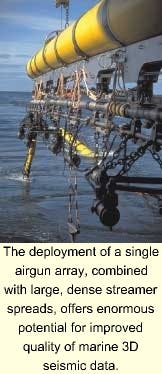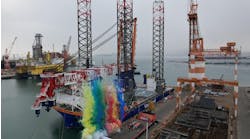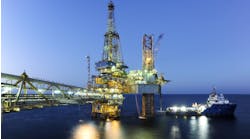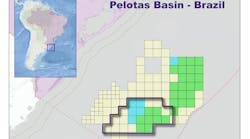The Ramform Valiant was launched by PGS in 1998 and has a capacity of up to 20 streamers in high-density towing configurations.
Despite the maturity of the marine 3D seismic market, new acquisition meth-ods promise to impact dramatically the way data is acquired in the future. This is due to the availability over the last few years of several new high-capacity third gener-ation seismic vessels.
Over the last few years, several marine 3D seismic operators have invested in the construction of new survey vessels. A feature of these new ships has been a steep increase in the amount of recording equipment towed. From 1985 to 1993, average streamer count per vessel for the industry's fleet rose from just two to around 3.5 streamers. Since 1993, it has risen to over seven.
The drive for increased streamer count was generated by the extra operational efficiency available through towing wider swaths of recording equipment. Through these means, routine 3D marine surveying costs have reduced by a factor of five during the last decade alone.
However, during the last two to three years, the operational dynamics of towing ultra-large streamer spreads has changed. In the early 1990s, as the trend toward larger spreads began to take off, seismic vessel towing capacity was limited by two factors:
- Towing capacity, limiting the overall practical width of the spread
- Streamer capacity, the number of streamers the vessel had available to use, regardless of spread width.
This is because during the early-to-mid-1990s, the world's seismic fleet was principally converted trawler-type vessels, with limited onboard space.
Operational compromise
Data comparison from overlapping 45 fold dual source 3D survey (left) and 102 fold single source 3D survey (right).
These vessels are able to tow streamer widths of 600-750 meters. In the interests of high operating efficiency and low surveying costs, vessels tended to tow their maximum practical number of streamers, and wherever possible, towed with the maximum spread width.
However, deploying receiver spreads in this way leads to relatively large spacing between streamers, and consequently to large spacing between lines of subsurface reflection points. This, in turn, reduces crossline sampling with an inherent potential for reduced interpretability of the 3D data volume.
In general, and in fact since the very beginning of commercial marine 3D surveying, seismic oper-ators have overcome the crossline sampling problem by deploying two seismic energy sources instead of one. These sources, separated typically by half the streamer interval, fire alternately along each line. This effectively solves the crossline sampling problem, but creates another. The cost of this method is in "fold."
Fold is the number of times a specific subsurface reflection point is illuminated during the course of shooting a line. High fold is a good thing, since it offers a higher signal-to-noise ratio (SNR) of each trace in the final dataset and because it allows for the more effective use of certain algorithms during processing. There is a solution to this set of compromises. This solution requires that a seismic vessel acquire 3D data with:
- Single source to maintain high fold
- Wide spread to maintain operational efficiency
- Low streamer spacing (high streamer count) to maintain crossline sampling.
Until recently, there were no acquisition systems available that could meet the above requirements. This has changed, however, with the introduction over the last few years of large third generation purpose-built vessels, combining high towing power with massive streamer counts. The industry currently numbers 10 vessels of this type worldwide that have achieved a streamer tow of at least 10 streamers.
Survey modeling
The advantages of the single source acquisition method were recently demonstrated on a non-exclusive survey shot by PGS in the Dønna Terrace West area offshore mid-Norway, during the summer of 2000. The survey area of 2,332 sq km is situated west of the Norne Field and north of the Heidrun Field. The water depth varies between 300 meters and 450 meters.
Previous seismic surveys in the region have suffered from very low SNR and strong multiple reflections, especially water-bottom reflections. The acquisition parameters of the Dønna Terrace West survey were derived from detailed modeling and analysis of existing 2D data and well information in the area.
The primary target for the survey is the strata between two seconds and five seconds, two-way time. The main challenges for the target zone are the severe multiple content and the low reflectivity. The survey design therefore focused on these problems.
Reflectivity modeling based on available well data showed that certain weak horizons at 2.5 seconds two-way time are completely masked by multiples. The modeling and analysis showed that high-fold surveying would be more successful than previous surveying efforts in the area.
As a result, the Dønna Terrace West survey was acquired with a single source, 12-streamer configuration, with a streamer length of 5,100 meters. This acquisition configuration has resulted in high fold coverage and improved data quality compared to traditional lower fold dual-source configurations.
Acquisition configuration
The deployment of a single airgun array, combined with large, dense streamer spreads, offers enormous potential for improved quality of marine 3D seismic data.
An added advantage of a single source configuration is that it allows for a more flexible source design. Since more sub-arrays can be deployed in the source, the total energy output can be increased for better penetration or configured for more directivity, if required.
Single source acquisition benefits the seismic processing in several stages. This can be very important for multiple attenuation. For example:
- In FK methods, a single source configuration will give improved offset sampling within the CMP domain, reducing the chance of spatial aliasing and improving the performance of the filter.
- In Radon methods, it is important to maintain equal shot and receiver spacing for optimum performance of the algorithm.
In dual source acquisition, the shot spacing is normally far greater than the receiver spacing, and Radon demultiple performance is therefore reduced. The improved data redundancy of single source data is significant in one way or another through the whole of the processing sequence. The velocity analyses (semblance, sensitivity stacks, etc.) will have improved quality due to the denser sampling and higher fold. The stack response itself will be improved through the enhanced quality of velocity analyses and the higher fold.
Poor data quality, as experienced in the Dønna Terrace West area, prohibits primary events from being distinguished in early stages of the processing and parameter testing. Data acquired with a single source will show better data quality, especially on stacked data at early stages. Therefore, the parameter testing will benefit from the single source configuration because there will be greater confidence in the parameter selection.
On high-end products, the higher fold will also improve the quality of angle stacks and AVO outputs because the higher fold improves the statistics of the estimation of these pre-stack attributes and due to improved pre-processing of the input data.
Options to single source
For dual source acquisition, improved sampling of CMP gathers can be achieved through interleaving or through the application of shot interpolation. Shot interpolation is occasionally applied as an alternative to single source acquisition to improve the sampling for multiple attenuation.
However, if multiples are very strong compared to the primary events and the SNR is poor, as in the Dønna Terrace West area, the interpolation of shot gathers with both primary and multiple events is difficult and can not replace real data.
The Dønna Terrace West survey was acquired using the Ramform Valiant in 74 days with one source and 12 streamers. The streamer separation was 75 meters, providing 37.5 meters subsurface line spacing. If the survey had been carried out using a dual source, eight-streamer configuration with a 100-meter streamer separation providing 25 meters subsurface line spacing, modeling suggests that the survey would have taken 72 days under the same conditions.
Since survey costs are driven primarily by vessel time on prospect, it is clear that massive, single source surveys using modern third generation seismic vessels are commercially competitive to top-of-the-art conventional vessels in dual-source mode, in terms of pure turnaround time and cost-per-unit area.
Data comparison
This new 3D survey partly overlaps several existing surveys. A data comparison with a dual-source survey that was acquired in 1999 shows that although the processing parameters are not strictly identical, the data quality of the single source survey is superior. The SNR is improved throughout the entire section, and the interpretation of primary events in the low reflectivity zone is significantly improved.
The 3D seismic survey acquired in the Dønna Terrace West area shows a significant improvement over other surveys acquired in the area with a dual source configuration. Some of this is attributed to improved processing techniques. However, the dense shot interval in combination with the longer streamers, compared to those used in previous surveys in this area, have made a significant contribution to improved data quality.
This survey proved that high productivity is possible on single-source surveys, making them competitive with conventional surveys on turnaround time and cost grounds. Given the added data quality improvements inherent in the single-source method, we feel convinced that this survey method will come to dominate in regions where seismic data quality is traditionally poor.
Acknowledgement
Petroleum Geo-Services granted permission to publish this article.




